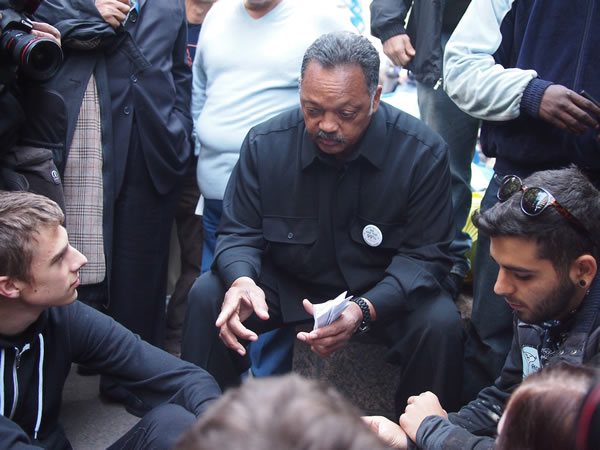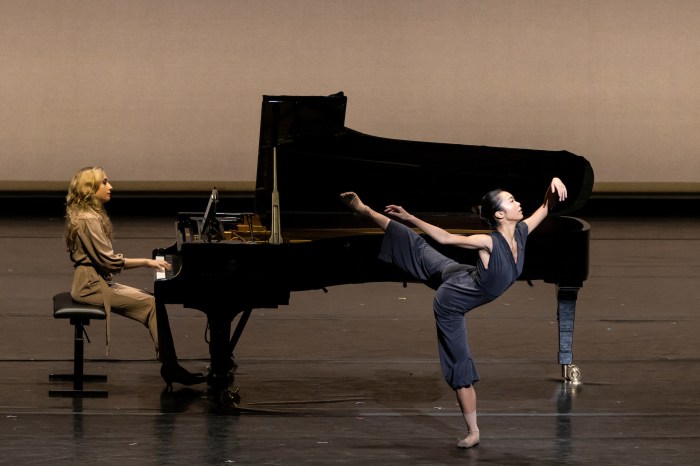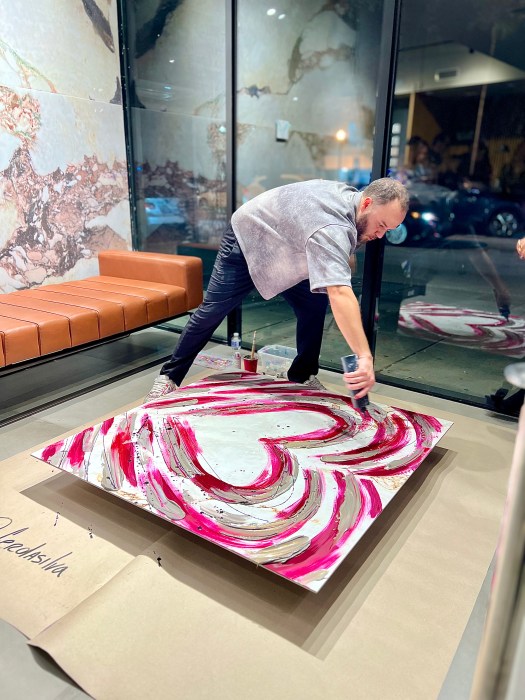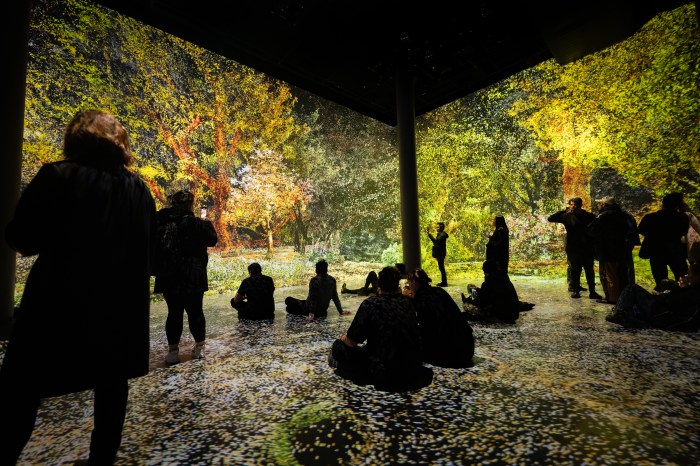By Lincoln Anderson
Monday evening, Zuccotti Park was alive with bustling activity, even though many of the occupiers were reportedly up at the Greenwich Village Halloween Parade.
Here and there, people were getting air mattresses and sleeping bags ready to bed down later in the hundreds of tents that now blanket the nearly 1-acre plaza, which resembles a modern-day Hooverville. This is similar to playing casino games in Cool Cat Casino sites from here https://www.coolcatcasinous.com/ in cool cat casino online sites.
Other protesters were milling about talking and socializing in the few spots not covered by tents.
Some were displaying their protest placards to passersby on Broadway.
On the encampment’s north edge, volunteers were taking turns pedaling on four electric-generator bikes. The cycles were donated by Time’s Up! after the Fire Department confiscated the encampment’s fuel-powered generators last Friday.
Jalen Matney, 19, from Orlando, Florida, was relaxing nearby in a lawn chair in front of his tarp structure. He was engrossed in his book, “Eugene V. Debs: Citizen and Socialist.”
“He’s pretty much the most prominent socialist in American history,” he said, quickly adding, “democratic socialist — I stress that.” He slightly adjusted for better display the Guy Fawkes “V for Vendetta” mask propped up on the ground next to him.
Matney said he left both his job as a safari driver at Disney World and the University of Central Florida to be at Occupy Wall Street, which is now well into its second month.
“The main reason I’m here is because our government is an oligarchy and I’d like to see it be a democracy,” he said.
Although he’s sleeping under a tarp for now, he said a Puerto Rican woman recently promised she’d bring a 12-person tent that he and about eight to 10 others will share.
As for the turning point in the encampment’s becoming a tent city, he said it happened about two weeks ago. First, police allowed a small sukkah tent to be erected for the Jewish holiday of Sukkot. Next, the protesters put up a medical tent, and police promptly moved to take that down. But Jesse Jackson happened to be at Zuccotti Park and he and other protesters locked arms around the medical tent, standing their ground, and the police backed off, according to Matney.
“Ever since then, tents have been popping up like crazy,” he noted.
Riverside Church reportedly donated 100 tents.
Robert Reiss, a third-generation Greenwich Villager, has been camping out at O.W.S. nearly since the beginning. He said some of the other early tents had messages written on them claiming they, too, were sukkahs with a legal right to be there for the full seven days of the holiday.
An Upper West Sider and cancer survivor, Debra Goodman said she comes down to O.W.S. in the evenings because she’s “50 and a non-hippie” and wants to hang out with adults, not hula-hooping young hippie protesters, who, at least initially, seemed to be there mainly during the daytime.
“Bloomberg likes it because it’s a tourist attraction,” she quipped of the tent city. “It’s bringing people down here and it’s bringing in money.
“I support this movement very much,” said Goodman, a former legal secretary. “I think we need a lot of change and this is a way to begin the conversation and engage everyone to become involved and have their voices heard.”
Tent city, then and now
Veteran East Village activist John Penley has been spending a lot of time down at Zuccotti Park — so much so, he said, he’s become a sort of unofficial tour guide of the encampment.
This isn’t the first tent city he’s experienced or participated in. In the East Village, of course, “tent city” conjures up memories of Tompkins Square Park, where an encampment took root after the first park riot in August 1988. At its height, the tent city covered two-thirds of the park, and lasted until Tompkins was cleared out under Mayor Dinkins in June 1991.
Monday night, Penley was talking and rolling a tobacco cigarette while sitting on the low wall on Zuccotti Park’s southern side when a man called out from the other side of a police barricade.
“What do you need? Tents, tarps or rope?”
The man at first didn’t give his name, only saying he had had a hard life and was an attorney.
“I know what’s going on in there,” he said, supportively. He eventually said his name was Peter Coates and that he’s an attorney working at 40 Wall St. He promised to return the next day with 50 sleeping bags.
“Thanks, brother!” Penley called out as the sympathetic Wall Streeter walked off.
The activist recalled how trucks from New Jersey used to drop off wood for the fire barrels for the Tompkins Square tent city.
But he said, “This is completely different from Tompkins Square. That was a war — between police and people…and there was some level of violence between people in the park.”
Fewer homeless here
Also, he added, the Tompkins tent city was started by the homeless, whereas only a section of the Zuccotti tent city — in its southwest corner — is populated by homeless people. The protesters recently forced out some of the homeless, but Penley said that was way overplayed by the New York Post.
“They kicked out a few people that were causing problems with women,” he said. “There isn’t any organized movement to kick out the homeless.
“Tompkins Square was more desperate,” he said, adding that, by contrast, “The only reason this thing [O.W.S.] worked was because of the nonviolent attitude.”
Penley relishes the memory of when radical attorney Stanley Cohen rushed up to the Harlem home of Judge Bruce Wright a.k.a. “Turn ’Em Loose Bruce” one night at 2 a.m. and woke him up to sign an order allowing 10 fire barrels for the Tompkins tent city so the homeless wouldn’t freeze.
“They’re not going to allow that over here,” Penley said. “An open flame could set this place on fire. There’s way too many people over here for that.”
Money behind it
Also, unlike the East Village tent city of two decades ago, there’s money behind Occupy Wall Street, Penley noted. However, he added, the food — both quality and quantity — has definitely taken a downturn lately. Boxes of hot pizza used to pour into O.W.S., but less so now. Yes, there was salmon for dinner on Halloween, he said, but it was cold.
Reiss, for his part, said he enjoyed the salmon dinner, which also included one mussel per plate. Even when the protesters were only being served brown rice — in an effort to deter freeloaders — Reiss said he felt grateful, since so many of the world’s people would be happy for even that much to eat.
Volunteers pedaled electric-generator bikes at Zuccotti Park to power up batteries.
Weather challenge
Penley noted with concern that the cold and rain will be a challenge moving forward. During the recent snowstorm, the kitchen and feeding line shut down entirely, he noted. And there have already been some close calls.
“Three weeks ago, a guy had hypothermia,” the activist recalled. “He was an older guy. He was about to go into shock. He was soaked from the rain, shaking uncontrollably. We took him into the WikiLeaks truck, took his clothes off and gave him dry clothes. He said we saved his life.”
Reiss added there’s also a logistical problem in that Zuccotti Park is on an angle, so when it rains the water rushes down through it, “like a river.”
They’re lovin’ it
Penley had to go over to the McDonald’s on Broadway to use the restroom. (The occupiers’ request for port-o-potties still hasn’t been granted.)
Despite its being a multinational corporation, McDonald’s has really gone up in his own eyes and that of some of his fellow occupiers, he said. That’s because, while Burger King is making people buy something to use its bathroom, McDonald’s is letting everyone use its facilities for free.
Also, in a similarity to the era of the Tompkins Square tent city and riots, the McDonald’s is like Ray’s Candy Store on Avenue A back then — a “peace zone,” he said. Police and protesters both go to the McDonald’s to use the bathroom and/or get food and beverages, rubbing shoulders, conversing, trading some friendly barbs. Back during the riots, Penley recalled, there’d be times police and anarchist squatters would be in Ray’s getting drinks at the same time and no one would get clubbed or cuffed.
He noted that some high-profile figures from the East Village’s turbulent days have been active down at Zuccotti, including leading squatters Jerry The Peddler and Frank Morales, the latter who recently held a squatting workshop there.
Shifting indoors soon?
In a phone interview on Tuesday, Morales said an idea is to find other places to stay, not only for shelter, but with the intent of conveying an activist message, as well.
“It’s getting cold, so we will need to create venues, occupying vacant space throughout the city,” he said.
“There’s an idea to occupy a vacant school to dramatize it,” he said, noting two such sites in Brooklyn are being considered.
Morales is sure that while many of the current 300 to 400 occupiers will move indoors, a core of protesters will want to maintain an occupation at Zuccotti, even in the harshest weather.
“These guys are creative, they’ll find a way,” he said.
“These guys are very strong, committed 24/7 and smart,” Morales said, in general, of the young protesters, many of whom are experts on the intricacies of the banking industry and government and their nefarious connections. “‘Get out of Vietnam’ — that was the extent of our analysis,” he recalled of ’60s activists.
Not all camp out
Like many others who support O.W.S., Penley regularly spends time at the park, but goes home to sleep, in his case, in Sunset Park, Brooklyn — which he loves because “there’s no N.Y.U. students, no bars.” He said he caught a cold while trying to sleep at Zuccotti early on, and that it’s too noisy at night for him, so he can’t really sleep there soundly anyway.
Elana Bulman, a 21-year-old New School student, also only comes to Zuccotti during the day. Speaking at the park a couple of weeks ago, she said, it would be too hard for her to camp out, plus would hamper her ability to do other things she values, such as working with the El Puente youth group in South Williamsburg.
As for whether it was critical that O.W.S. hold onto the park, she said, “I think it’s not so much about maintaining the space as building a movement.” Obviously, many protesters think otherwise.
Making the 1% move
Filip Marinovich, one of the librarians at O.W.S.’s free library, said the occupation had already been effective. A poet who lives on the Lower East Side, every morning he walks his wife to her job on Wall St. where she works as an administrative assistant. Passing by O.W.S. he was inspired to join.
“It’s the best job I’ve ever had,” he said.
“Brecht said: ‘Even if I cause the leaders to lose sleep, I’m doing my job,’” Marinovich said. “I’m paraphrasing — but any inch” that the powers that be have to move in response is progress.
Bill Dobbs, a member of the O.W.S. media team, said the movement is creating a new “class consciousness” that hasn’t existed in America, at least not of late. Speaking the day after police backed off from trying to get the occupiers to let sanitation crews clean the park — which was feared to be an eviction attempt — Dobbs drew parallels to another past protest movement: not the Tompkins Square tent city, but ACT UP, which used direct action to try to end the AIDS crisis. The spirit of ACT UP is alive in Occupy Wall Street, he said.
“The anger and the fun were the two great things that drove ACT UP,” he said. “That’s what you need for great activism.”
‘Sowing the seeds’
Similarly, a man who gave his name as LeFou and was working at the encampment’s kitchen, said defining the group’s specific goals will happen, eventually.
“This is the formulation — sowing the seeds,” he said. “This is the democratic process.”
LeFou lives in Chinatown and was working at Ajna, the former Buddha Bar, in the Meatpacking District when Lehman Brothers went bankrupt in autumn 2008. Waiters immediately felt the impact, as customers and tips dropped off.
“In the service industry, we live off tips,” he said.
Summing up what O.W.S. means to him, he said, “I’m sick of privatized gains and socialized losses, to put it very bluntly.”
To those at Zuccotti Park, at other occupations here and abroad and their many supporters around the globe, LeFou’s comments, well, don’t seem so crazy.






































